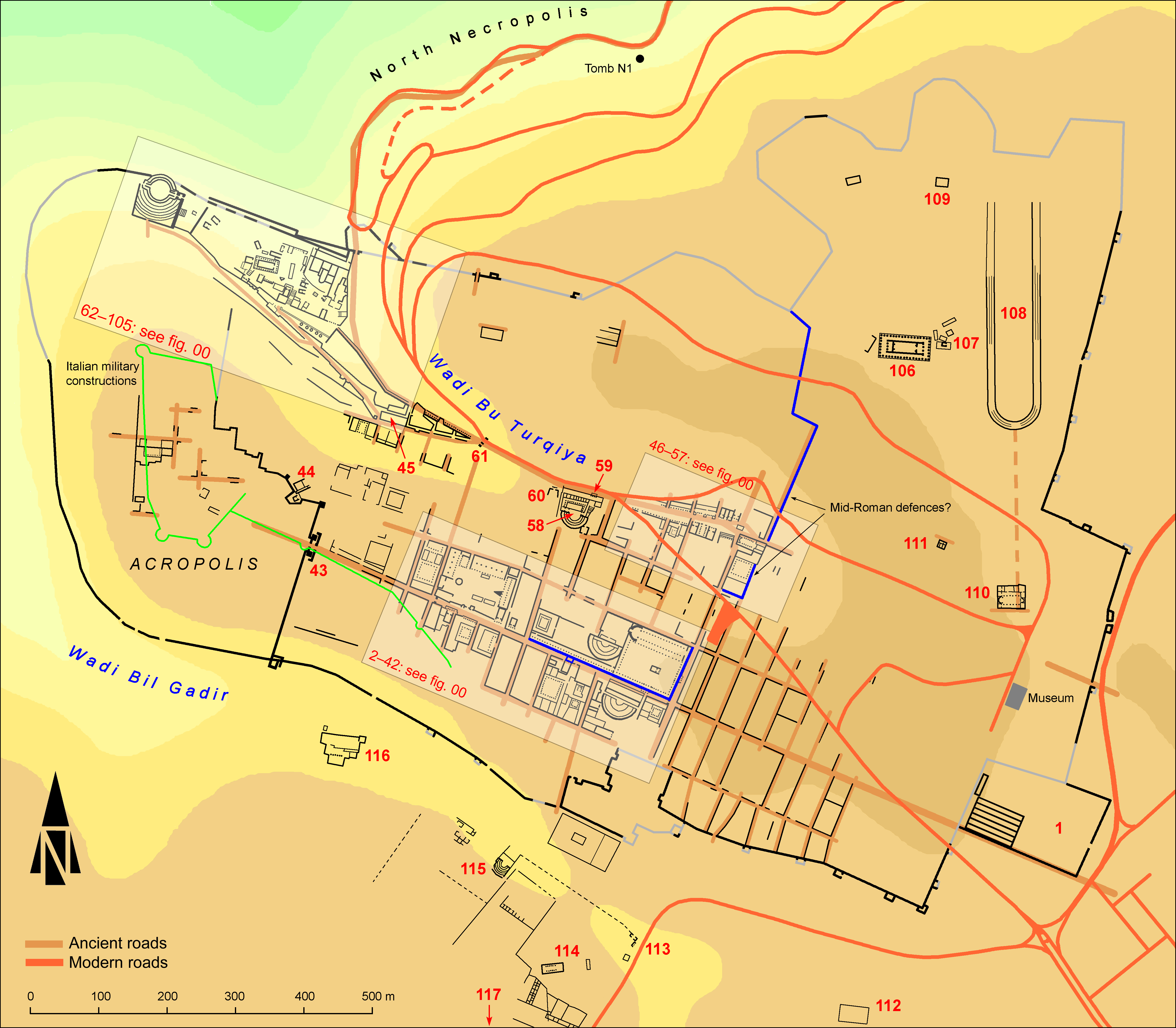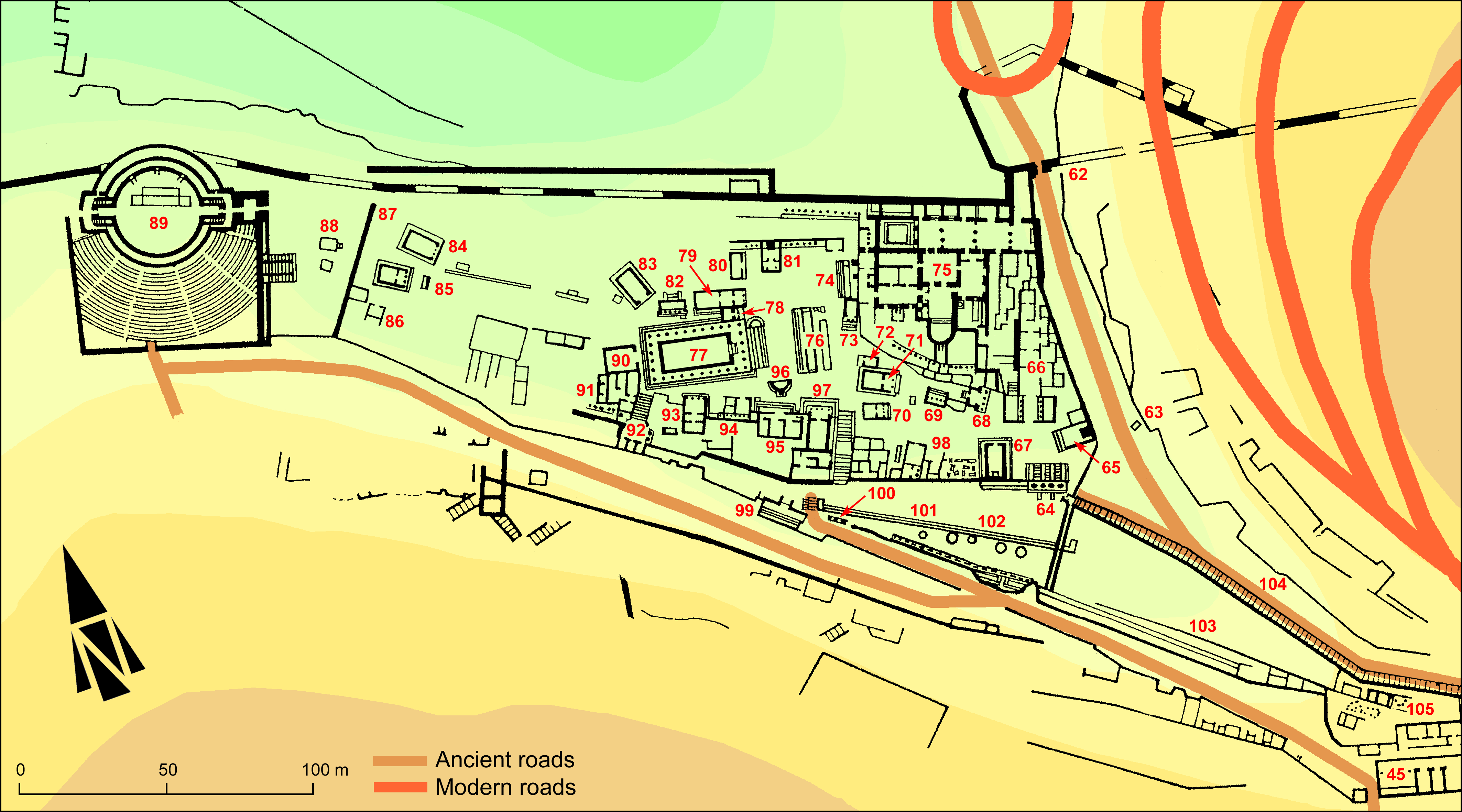EpiDoc XML:
IGCyr1002002
Trismegistos ID:
5963
Source description
Support: Fragmentary white marble panel, broken on all sides but for the left edge and for a very short part of the right edge, at l. 7 (w: 0.195 × h: 0.21 × d: 0.6).
Layout: Inscribed on two columns, separated by a vertical line down to l. 7; lower on, the separation being not prepared, the width of column 1 is less regular and at some lines the letters had to be much pressed together.
Letters: 0.06; careful letters with slight serifs; alpha with dropped bar.
Date: Second half of second century BC (lettering).
Findspot: Plausibly found by G. Oliverio in 1937 at Cyrene ➚: probably in the Sanctuary of Apollo (see commentary)..
Last recorded location: Cyrene Museum, 437. Seen by C. Dobias-Lalou in 1977 in Shahat: Cyrene Museum.
Text constituted from: Transcription from stone (CDL).
Bibliography
Oliverio , IV.6, whence Pugliese Carratelli 1960 and SECir, 158; Sokolowski 1962, pp. 196-198, n. 116 and Robert, BE, 1963.307, whence SEG, 20.719; Dobias-Lalou 1985, p. 180, whence SEG, 35.1687; Grosjean-Agnès 2012 (new text by C. Dobias-Lalou), whence SEG, 62.1788; IGCyr 100200 ➚; CGRN, 190 (J.M. Carbon, S. Peels); Marengo 2022, pp. 133-134 and Dobias-Lalou, BE, 2023.553. Rosamilia 2023, pp. 277-279, number 23 (text)
Cf. Pugliese Carratelli 1964; Laronde 1987, pp. 425-427; Dobias-Lalou 2000, passim and especially pp. 149 and 231, whence SEG, 50.1637; Parisi Presicce 2007 and Dobias-Lalou, BE, 2008.602, whence SEG, 57.2025; Harris – Carbon 2015, 117; Chevrollier 2018-2019, pp. 74-76, whence SEG 68.1742.
Text
[.]+++[---]
[Ἀ]νέμοις α̣[ἴξ c. 2 - 3]
Ἀπόλλωνι Ἀπ[ο-]
τ̣ροπαίωι αἴξ, ⟦ὗς⟧
5ἀλλὰ χίμαρος·
Ζηνὶ Ὑπερφορεῖ
οὐθὲν ἔμψυχον
θύεται, οὐδὲ ὑ-
ποδεδεμένος
10πότει οὐδὲ μύρτα
ποτοίσες·(vac.)
Τελέσσαις αἴξ, ὗς·
Ζηνὶ Πανθείωι καὶ
Ἀθαναίαι Πανθείαι,
15Ζηνὶ Ὑπελλαίωι
καὶ Ἀθαναίαι
Ὑπελλαίαι αἴξ·
Ἰατρῶι(vac. 2) ὗς·
Ζηνὶ(vac. 1) αἴξ,(vac. 1) ὗς·
20Ἄμμωνι καὶ τοῖς
περινάοις ὄις·
[------]
[ - - - - - - - - - - ]
[ - - - - - - - - - - ]
[ - - - - - - - - - - ]
τῶι̣ [c. 8 - 11]
καὶ τοῖς π̣[αρέδροις]
Ἀθαναίας αἴ̣ξ̣·
τοῖς δὲ ἐν τᾶι ἀ-
γορᾶι καὶ τοῖς ἐ[ν]
τῶι πρυτανείω[ι ὗς],
Παιᾶνι καὶ̣ [τοῖς]
παρέδροις ὗ̣[ς ..]
Νύμφαι[ς c. 5]
πλὰν τ[ᾶν ἐν τᾶι]
νάπα̣[ι c. 5]·
Ἀπόλ[λωνι Νυμ-]
φα[γέται αἴξ]
Ἀπ̣[όλλωνι c. 5]
Π[---]
[------]
[------]
[------]
[------] -
[+]+++[---]
[.]ΝΕΜΟΙΣ.[..c. 2 - 3]
ΑΠΟΛΛΩΝΙΑΠ[.-]
.ΡΟΠΑΙΩΙΑΙΞ⟦ΥΣ⟧
5ΑΛΛΑΧΙΜΑΡΟΣ
ΖΗΝΙΥΠΕΡΦΟΡΕΙ
ΟΥΘΕΝΕΜΨΥΧΟΝ
ΘΥΕΤΑΙΟΥΔΕΥ
ΠΟΔΕΔΕΜΕΝΟΣ
10ΠΟΤΕΙΟΥΔΕΜΥΡΤΑ
ΠΟΤΟΙΣΕΣ
ΤΕΛΕΣΣΑΙΣΑΙΞΥΣ
ΖΗΝΙΠΑΝΘΕΙΩΙΚΑΙ
ΑΘΑΝΑΙΑΙΠΑΝΘΕΙΑΙ
15ΖΗΝΙΥΠΕΛΛΑΙΩΙ
ΚΑΙΑΘΑΝΑΙΑΙ
ΥΠΕΛΛΑΙΑΙΑΙΞ
ΙΑΤΡΩΙ ΥΣ
ΖΗΝΙ ΑΙΞ ΥΣ
20ΑΜΜΩΝΙΚΑΙΤΟΙΣ
ΠΕΡΙΝΑΟΙΣΟΙΣ
[------]
[ - - - - - - - - - - ]
[ - - - - - - - - - - ]
[ - - - - - - - - - - ]
ΤΩ.[c. 8 - 11]
ΚΑΙΤΟΙΣ.[........]
ΑΘΑΝΑΙΑΣΑ..
ΤΟΙΣΔΕΕΝΤΑΙΑ
ΓΟΡΑΙΚΑΙΤΟΙΣΕ[.]
ΤΩΙΠΡΥΤΑΝΕΙΩ[...]
ΠΑΙΑΝΙΚΑ.[....]
ΠΑΡΕΔΡΟΙΣ.[.++]
ΝΥΜΦΑΙ[.+++++]
ΠΛΑΝΤ[.......]
ΝΑΠ.[.+++++]
ΑΠΟΛ[.......-]
ΦΑ[........]
Α.[......+++++]
Π[---]
[------]
[------]
[------]
[------]
Apparatus
1-21.a-b: had a text, provided by C. Dobias-Lalou, which was the same as presented at IGCyr Grosjean-Agnès 2012
a.2: [c. 2 - 3] Pugliese Carratelli 1960, SECir, IGCyr: [ὗς?] rosamili2023
a.4: ⟦ὗς⟧ not seen by the previous editors
a.5: ἄλλα Dobias-Lalou 1985: μᾶλα Pugliese Carratelli 1960, SECir; μάλα Sokolowski 1962, Pugliese Carratelli 1964 the meaning would be 'sacred strip'
a.12: ὗς Pugliese Carratelli 1960, SECir, CGRN: ⟦ὗς⟧ IGCyr
b.3: [------] Pugliese Carratelli 1960, SECir, IGCyr: [θεοῖς --- ἐν] Rosamilia 2023; [--- τοῖς ἐν] Sokolowski 1962, SEG
b.4: τῶι̣[c. 8 - 11]: ΤΩ[---] Pugliese Carratelli 1960
b.5: τοῖς π̣[αρέδροις]: τοῖς π̣[ερινάοις] also possible, as at l. 21; τοῖς Ι[---?] CGRN; τοῖς ἐ̣[ν τῶι] Sokolowski 1962, SEG, Rosamilia 2023; τοῖς +[---] SECir
b.6: αἴ̣ξ̣: αἴ̣[ξ] Pugliese Carratelli 1960, SECir
b.9: [ὗς] Rosamilia 2023: [..] CGRN; Pugliese Carratelli 1960, SECir, Sokolowski 1962, IGCyr not restored
b.10: καὶ̣ [τοῖς]: ΚΑΡ[---] Pugliese Carratelli 1960, SECir; Καρ[νείωι] Robert, BE, Pugliese Carratelli 1964
b.11: ὗ̣[ς..]: [---] Pugliese Carratelli 1960, SECir
b.13: τ[ᾶν ἐν τᾶι]: τ[---] Pugliese Carratelli 1960
b.14: νάπα̣[ι]: ΝΑΠ[---] Pugliese Carratelli 1960
b.15-16: Ἀπόλ[λωνι Νυμ-]|φα[γέται αἴξ] Sokolowski 1962, Marengo 2022, Rosamilia 2023: Ἀπόλ[λωνι ---] | ΦΑ[---] Pugliese Carratelli 1960, SECir, IGCyr
b.17: Ἀπ̣[όλλωνι c. 5] Rosamilia 2023: ἄρ[σεν c. 7] Marengo 2022; ΑΓ[---] IGCyr; ΑΙΤ[---] Pugliese Carratelli 1960, SECir
b.18: Π IGCyr, Rosamilia 2023: Γ Pugliese Carratelli 1960, SECir
French translation
(col. a) [---], pour les Vents, une chèvre, pour Apollon Apotropaios, une chèvre, plus précisément un chevreau de l'hiver; pour Zeus Hyperphoreus, on ne sacrifie pas d’être vivant, ni on ne (10) pénètre chaussé, ni on n’apporte de myrte; pour les Telessai, une chèvre, un porc; pour Zeus Pantheios et Athèna Pantheia, pour Zeus Hypellaios et Athèna Hypellaia, une chèvre; pour Iatros, un porc; pour Zeus, une chèvre, un porc; (20) pour Ammon et les dieux voisins, un mouton [---].
(col. b) [---], pour les dieux voisins d’Athèna, une chèvre ; pour les divinités de l’agora et du prytanée [un porc], (10) pour Paian et les dieux voisins un porc, pour les Nymphes [---] excepté celles du ravin [---]; pour Apollon Nympha[gètas, une chèvre]; pour Ap[ollon ---].
English translation
(col. a) [---] for the Winds, a goat, for Apollo Apotropaios, a goat, more exactly a winter-old he-goat; for Zeus Hyperphoreus, no living being should be sacrified, nor should one (10) come in with shoes on, neither bring myrtle; for the Telessai, a goat, a pig; for Zeus Pantheios and Athena Pantheia, for Zeus Hypellaios and Athena Hypellaia, a goat; for Iatros, a pig; for Zeus, a goat, a pig; (20) for Ammon and the neighbour gods, a sheep [---].
(col. b) [---] for the gods neighbouring Athena, a goat; for the gods of the agora and of the prytaneion [a pig], (10) for Paean and the neighbour gods, a pig, for the Nymphs [---] except those of the ravine [---]; for Apollo Nympha[getas a goat]; for Ap[ollo ---].
Italian translation
(col. a) [---], per i Venti, una capra, per Apollo Apotropaios, una capra, più precisamente un capretto nato d'inverno; per Zeus Hyperphoreus, non si sacrifichi alcun essere vivente, né si entri (10) con le scarpe, né si porti mirto; per le Telessai, una capra, un maiale; per Zeus Pantheios e Atena Pantheia, per Zeus Hypellaios e Atena Hypellaia, una capra; per Iatros, un maiale; per Zeus, una capra, un maiale; (20) per Ammon e gli dèi vicini, un montone [---].
(col. b) [---], per gli dèi vicini di Atena, una capra; per gli dèi dell'agora e del pritaneo [un maiale], (10) per Peana e gli dèi vicini, un maiale, per le Ninfe [---] fatta eccezione per quelle del vallone [---]; per Apollo Nympha[getas, una capra]; per Ap[ollo ---].
Commentary
There exists some confusion about the findspot of this stone: Pugliese Carratelli 1960 wrote that it was found in 1937 in the Sanctuary of Apollo, commonly called 'Piazzale'; however in SECir, the same editor, citing Oliverio's notebook, mentions as findspot «nello scavo n. 2 (ad Est del Pritaneo)», i.e. on the agora near the Prytaneum. The photograph from the Department of Antiquities confirms the date 1937, a year for which unfortunately no excavation report may help (see Luni 2014, p. 153 and footnote 10). We only know that Oliverio spent some time at Cyrene during that summer (he was no longer Controller of the Antiquities) and he probably took part into the discovery.
As sacrifices are prescribed to various gods and goddesses, often with epithets known only here, the place should not be necessarily the sanctuary of Apollo, although it hosted many other deities. That this panel would have been exposed on the agora is quite possible and we prefer to follow Oliverio's indications. This also fits well the mention of 'gods of the agora and of the prytaneion' at lines 29-31 (which cannot be taken as refering to the so-called Agora of the Gods in the sanctuary of Apollo, pace Parisi Presicce 2007, p. 495, footnote 13).
The restoration proposed here for b.14 is based on the rare root ναπ-; with small traces of alpha, it seems to be the fem. νάπα rather than the neuter νάπος. Sanctuaries of Νύμφαι are already known on the Fountain Terrace and on the Western slope of the Acropolis, which might be the place mentioned here but still lacks any inscribed documentation. Nymphs are also mentioned in the extra-mural sanctuary of Demeter and Kore, near Theatre 5, and at the more remote site of Budaraj, for which the word would also be appropriate. See further discssion by Dobias-Lalou 2020, pp. 56-62. As pointed out by Rosamilia 2023, there is space for the name of the victim either at line b.12 or b.14. Various possibilites exist, amongst which his suggested παίσαις 'all' is attratctive, although perhaps a little too long.
At ll. b.15-16, Sokolowski's suggested reading of Apollo's epithet Nymphagetas, missed by Dobias-Lalou for IGCyr, was duly restored by Marengo 2022 and Rosamilia 2023. The epithet was thus much more ancient than the mention already known, dating from 172/175 AD (IRCyr2020 C.305). In this list, it has a sensible place after the Nymphs, whereas the very different Apollo Apotropaios is mentioned at ll. a.3-4. A third mention of Apollo, most probably with another epithet followed at b.17-18, as proposed by Rosamilia 2023. Dobias-Lalou's squeeze confirms the pi as much more probable than the rho suggested by Marengo 2022.
Some epithets of gods are here quite new. In his first edition, Pugliese Carratelli (Pugliese Carratelli 1960) discussed the new ones. For Ὑπελλαῖος /-α the most convincing interpretation is that from ὑπέρ-λαιος 'with the left hand up'. Zeus and Athena are here twice associated with parallel epithets, as stressed by Chevrollier 2018-2019 About the mysterious Telessai, see a tentative etymology by Dobias-Lalou 2000, pp. 230-231 and for their figure Grosjean-Agnès 2012; for them, a goat and a pig were suitable victims, whereas the same pair was initially also engraved at line 4 for Apollo Apotropaios and the pig being then erased. Conversely, in our first edition (IGCyr), we mentioned the same erasure at a.12, which was a pure error, duly picked out in CGRN (consulted March 2022)
CC BY-NC-SA 4.0 Deed Attribution-NonCommercial-ShareAlike 4.0 International License.
All citation, reuse or distribution of this work must contain a link back to DOI: https://doi.org/10.60760/unibo/igcyrgvcyr2 and the filename (IGCyr000000 or GVCyr000), as well as the year of consultation.


